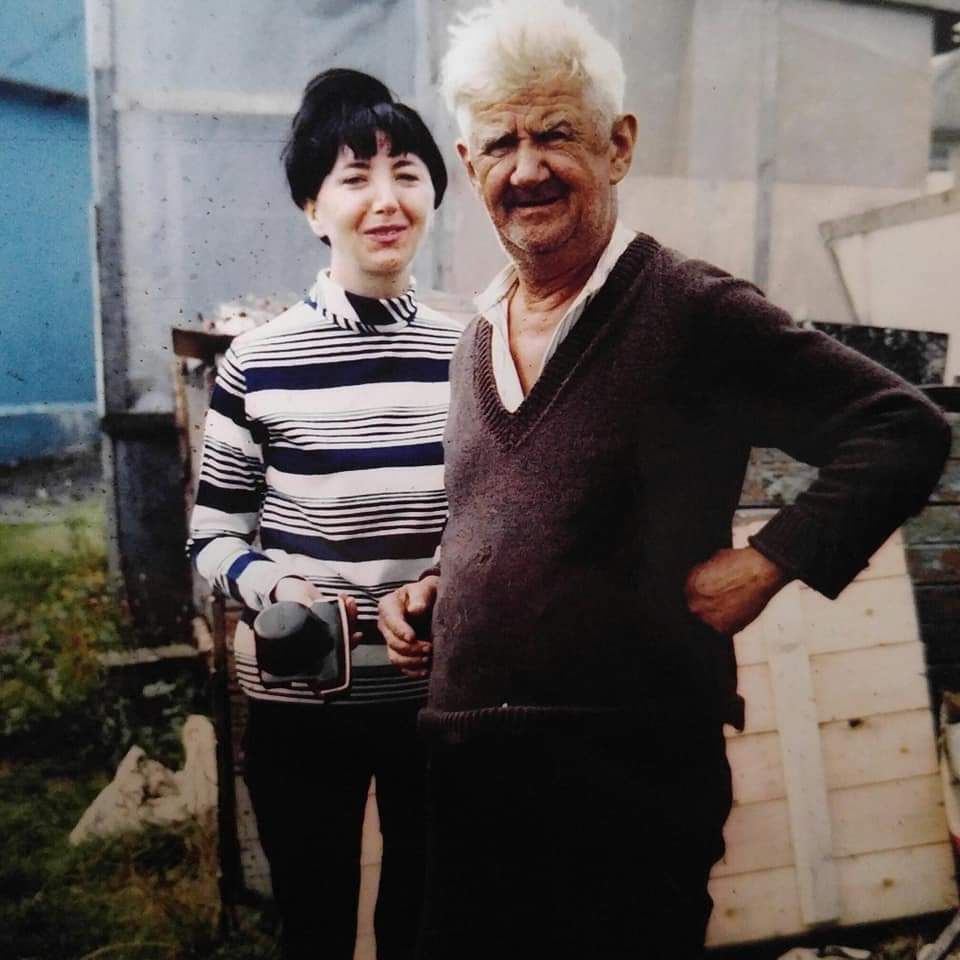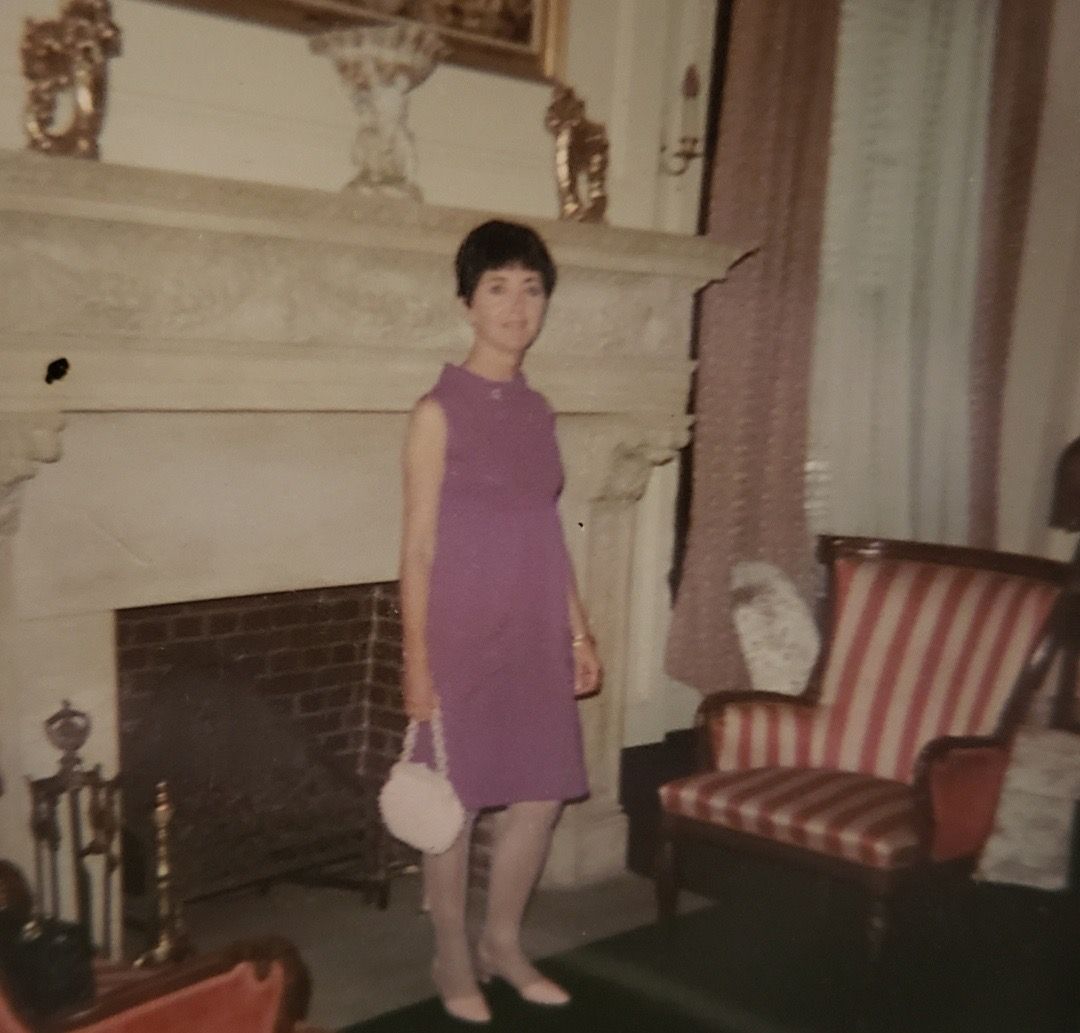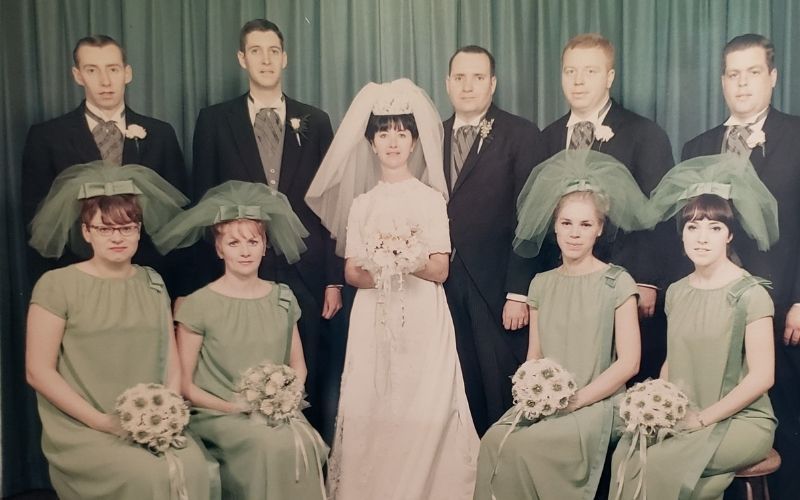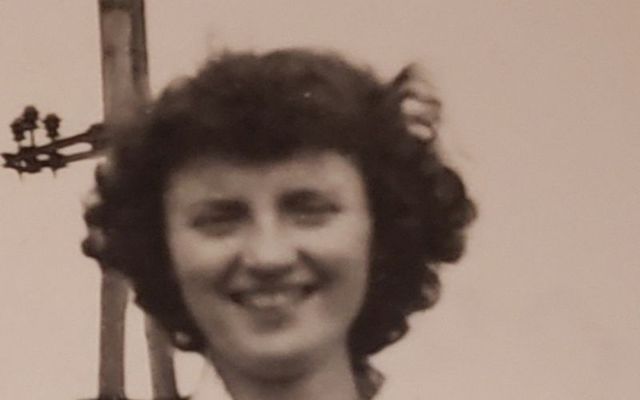20 years ago for my birthday, I invited my parents to join my wife and I in making a trip to Gettysburg, Pennsylvania to visit the historic town and its famous American Civil War battlefield.
Like so many folks, we opted for the self-guided auto tour to orientate to the expansive grounds and the epic narrative of events that unfolded over three days in July 1863.
Of particular interest to us were the myriad of memorials and monuments erected in honor of Irish and Irish-American regiments who fought and died there. My mother was especially moved by the massive Irish Brigade monument with its Celtic cross and sculpted sleeping Irish Wolfhounds at its base.
At that moment, my mother exuded a sense of stoic pride in her dual identity as being unquestionably Irish and yet thoroughly American. Before we left Gettysburg we discovered a hybrid Irish import and Civil War-themed souvenir shop. While there I found and clandestinely purchased an “emigrant ring” for Mom as a reminder of our special day. The ring was a simple but striking piece of jewelry. Made of sterling silver, its design was similar to the famous Claddagh rings. While this “emigrant ring” featured the familiar hands on either side of the heart, the crown surmounting the heart was absent. Instead of the hands holding the heart they were tugging at opposite sides of it. the intimated forces creating a break in the outline of the figure.
The symbolism was certainly not lost on my mother, whose countenance was contemplative at first, only to be replaced with a steady trickle of tears shed in a flood of emotions which were, to paraphrase a lyrical line from the song When New York Was Irish “ever so happy, ever so sad."
My mother, Bridget Ryan, was born on January 27th, 1935 in the little town of Castlecomer located in the northern reaches of County Kilkenny. She was the next to youngest of seven surviving children of John and Francis “Fannie “Ryan (nee Owens).
Mom’s father was born and raised in Chapel Lane in Kilkenny City. He was a shoemaker by trade. John was a World War I POW and afterward, he served in the Irish Free State army; Mom’s mother was born into a sizeable Owens family who had settled in Castlecomer a few generations earlier after arriving from Wales. Francis’ Owens’ grandfather, father, and uncle were bakers who supplied bread to the local workhouse for the indigent poor.
My mother’s hometown isn’t as widely known as other Irish locales made famous in song and story, and yet it could be a tableau representative of so many of the scenes from Ireland’s history. Within its compact core, you will find the handsomely ornate Immaculate Conception Roman Catholic Church built in the wake of the Catholic Emancipation movement championed by the liberator Daniel O’Connell in the first half of the 19th century. The adjoining graveyard’s varied landscape of monuments serves as a tangible repository for the memory of past generations. Close by is the aforementioned infamous 19th-century workhouse and its associated mass grave.

Bridget with her father John Ryan, back in Castlecomer in 1968 during her honeymoon trip back home with her newlywed husband Daniel Howarth.
While that structure stands in stony silence as a testimonial to the trespasses perpetrated against so many unfortunate souls, the local community lovingly reclaimed the site of the mass grave, maintaining it in a starkly simple way that speaks to the sanctity of the site. Castlecomer was heavily damaged by fire and other destructive forces unleashed by the conflagration of the 1798 Rebellion. Under the landed aristocracy of the Wandes ford family, the town was rebuilt along the lines of being one of Ireland’s first planned communities and its town square was modeled on a community in France. For a significant portion of its history, Castlecomer was associated with coal mining well into the 20th century and my mother often recalled how the coal train passed right by their back garden and how the coal miners used to jauntily wear their caps askew on their heads. I’ve mused in the past how this must have been a small sign of the bravado it took to do that dangerous work and to engage in labor agitation underscored by Communist influences across several decades of social upheaval in Europe.
Being a first-generation Irish-American on my mother’s side established deep roots that naturally nurtured my Irish identity and nourished my interest in all things Irish. As it turns out my father’s maternal grandmother was from Dunnamaggan, County Kilkenny, an even smaller agricultural community only a handful of miles from Castlecomer. This paternal great-grandmother of mine died a couple of years before I was born so that left my mother as the singular link to the old sod.
My mother would sing Irish lullabies and whimsical children’s songs. On Sundays, after Mass, she’d unabashedly turn up the volume on the radio and tune into the local Irish music programs. Most weeks my mother would seek out a copy of the Irish Echo or the Irish Voice newspaper. The ubiquitous cup of steaming hot tea was ALWAYS close at hand...even on the hottest, most humid of summer days. My mother told us kids it was the best way to cool down and we would just look at her dumbfounded!
Naturally enough my mother referred to Ireland on a regular basis and reflected on both her personal past and nuggets from her family’s history. She’d regale us with anecdotes like how her maternal grandfather was educated in the “hedge schools and how he claimed to have once seen the “Little People”. There were reminisces about how her favorite uncle would take her on trips to a seemingly alien Belfast in the North to visit one of the Owens cousins who owned the Union Hotel on Donegal Square near the Belfast City Hall.
Then there was the indignant retelling of how my grandfather was harassed and roughed up by the Black & Tans at the town barracks in spite of his status as a World War I veteran of the British Army. Perhaps it was the myriad of casual comments about everyday life in the Ireland of her childhood that used to catch our attention. Growing up in suburban America in the late 20th century made it hard for my brother, sister, and I to comprehend what it would be like to live without indoor plumbing, to be satisfied with humble and predictable meals, or to experience schooling where corporal punishment could be administered for real or perceived infractions of the rules.
My mother attended an all-girls school operated by the local order of Presentation nuns. Apparently one day a young Bridget came home with evidence of gratuitous punishment having been administered, and it apparently infuriated her mother Francis so much that she marched right down to the convent and told the nuns that if such extreme action was ever taken again that she’d sooner enroll her daughter in the Protestant school!
But most of all it was almost incomprehensible to imagine what it was like to leave your family and the whole world you knew behind. With a sense of finality.
America Calling
The prospects for a young single woman in 1950s Ireland would be considered limited at best and predetermined at worst by the societal standards of today. For the vast majority of girls, a formal education is concluded upon completion of primary school. Many acquiesced to the pressing domestic chores and economic need presented by the existence of large families. Single women found positions in clerical or service jobs until the prospect of marriage or religious vocations fundamentally shifted their priorities.
Sometime after leaving formal education around the 8th grade or so my mother was encouraged to join her older sister Margaret in Dublin for a while. Margaret had a growing family of her own and her husband worked on the electric trams and at the railroad operations at Connolly Station. She helped out in her sister’s household for a time while also taking a job at Cleary’s department store on O’Connell Street. But while living in Dublin provided broader horizons than rural Castlecomer, a 19-year-old Bridget Ryan was possibly a bit restless and perhaps unsure about her place in the world. The socioeconomic conditions in Ireland during the 1950s were stagnant. The country’s industrial development remained anemic. In a way, Ireland was also paying a price in the postwar years for its neutrality during World War II and its recent declaration as a wholly independent republic in 1949, eschewing all ties to the British Commonwealth.
It can be argued that the theocratic power and influence wielded by the Catholic Church in both government and Irish society, in general, was stifling modernity and progress. My mother was a part of the last sustained wave of legal Irish emigration to the United States before the signing of the Immigration Nationality Act of 1965. Bridget’s Aunt Mary came to America in the last major wave of emigration in the 1920s. Since that time she had occasionally returned to Ireland on visits and extended the time-honored opportunity to nephews and nieces to be sponsored and afforded the money for passage to come to America by this time several of my mother’s older siblings had emigrated to England rather than the United States. When Bridget’s brother Bill declined their Aunt Mary’s offer in favor of the short ferry ride across the Irish Sea, my mother leaped at the chance. The passage funds were a loan. Not a gift. Bridget was to pay for that advance outside of a simple financial obligation in order to make her way in the New World.
It’s challenging for us to comprehend in our age of instant connectivity and easily accessible transportation how significant the gulf still was between both sides of the Atlantic. I think that author Colm Tobin’s novel Brooklyn mirrored my mother’s experience in the mid-20th century very well. In May of 1954, she set sail for America from Cobh, County Cork on the SS Britannic at a time when transatlantic crossings would gradually start to favor taking to the skies over the centuries-old mode of travel by sea. She had her share of difficulty with seasickness on the journey. Her first glimpse of the Statue of Liberty or the striking Manhattan skyline might have been somewhat tempered by her desire after a week to finally get off the ship.

Bridget as a single young woman stepping out in the Big Apple.
Ellis Island had been closed down for over a decade by the time she arrived in New York City, so she was processed unceremoniously on board the ship. Once she alighted onto the West Side pier she met her Aunt Mary and for the first time her first cousins Madge, Francis, and Gertrude.
When asked to recall her first memory upon her arrival in the Big Apple my mother referred to the enormous, brightly colored taxis, the hurried streets, and the fact that the taxi driver was black. It was the first time she had met anyone of another race. The city’s diversity and dynamism were something Bridget embraced immediately and equated with what it meant to be an American.
Mom’s first home was with her aunt’s family on Brook Avenue near St. Mary’s Park in the old South Bronx, followed by the household's move to University Avenue in the nearby Irish stronghold of Highbridge. In time my mother found the need to strike out on her own. She found a unique accommodation farther uptown at a charitable residence, the Susan Devin Home for Self-Supporting Women on the Grand Concourse and East 199th Street.
The Susan Devin was a dormitory-style, single-room occupancy apartment building which was run by Catholic nuns who supplied affordable housing and communal support to single women living alone in the big city. My mother made many friends while a resident there and she remained a tenant of the Susan Devin until she got married. As a single young emigrant woman, she tried her hand at a variety of jobs. She worked at a range of iconic New York businesses which are now a distant memory. Her employers included the Horn & Hardart’s Automat on East 42nd & 3rd Avenue. The Automat was a cafeteria-style precursor of fast food establishments. It was a purveyor of prepared foods dispensed through coin-operated vending machines. Its customers were a cross-section of New Yorkers from celebrities to starving artists to the everyday working men and women of the city gathered from disparate corners of the globe.
She also had a one-day stint working at Gimble’s department store in Herald Square as an elevator operator. Once again, motion sickness endeavored to undermine her experience. For a time, Bridget enjoyed working for a jeweler in Manhattan’s “Diamond District” on West 47th street and performing clerical work at the New York Metropolitan Life company. She also scraped up extra cash babysitting for the children of her first cousin Madge and another maternal aunt who lived in Yorkville on the Upper East Side.
It wasn’t all work and no play for Bridget. Indeed, my mother used to jokingly chide me in my younger adult years saying “aww... you kids, I had more fun back then than you’ll ever know”, and quite frankly, I still believe her. My mother came of age in an era of perceived innocence. It was a time that was just seeing the dawn of a mass media culture and a revival of consumerism. There were still strong urban ethnic and parish social networks that were yet to be unraveled by migration to the sprawling suburbs. People didn’t sit home for long stretches watching TV or glued to a computer, tablet, or smartphone.
They stepped out on a regular basis. There were the multi-feature movies to go to….dances and socials to attend at church halls. The innumerable city bars carried on fulfilling a role as a community meeting place just as pubs did back in Ireland.
My mother figuratively had the world at her feet with the wonders of Manhattan only a 20-minute subway ride away. There were summer vacations out on what was called the “Irish Riviera”, Rockaway Beach in Queens, where Irish New Yorkers by the thousands decamp to rented bungalows and boarding houses to soak up some sun and surf in the summer months.
My mother’s cousins and friends euphemistically described it to her as “like going to Florida”! Of course, there was always the craic to be had at the aforementioned Irish bars. Convivial conversations, music, and high spirits were always on offer. My mother and her girlfriends were smart about doing things in groups or using the buddy system for outings like blind dates as there was greater safety in numbers.
My mother remained single into her early 30s, which wasn’t unusual for Irish or Irish-American men and women. Dating in multi-ethnic New York afforded opportunities to meet different people, which of course could also result in cultural friction. On one particular double date that wasn’t going well with an Argentinean, the man in question thought he was making a disparaging remark by saying “You know what? You have the map of Ireland all over your face”. That remark pleased her to no end and she simply exclaimed “oh…thank you very much! One day in 1966. my mother and some of her friends walked into the Longford Arms bar on Ogden Avenue & West 164th Street where she met my father, Daniel, who was born and raised in the neighborhood.
Legend has it that it was my mother who made the first move, coming up behind my father and tapping him on the shoulder. Supposedly Bridget and her girlfriend Doris had little in the way of funds with them for frivolity, so they ingratiated themselves with my father and some of the lads and later joined a group of folks headed up the block to another bar, Healy & Hogan’s. By the end of the evening, Bridget and Doris realized that they didn’t have cab fare for the ride home. My mother believing in the mantra “poor but proud” thought she couldn’t possibly accept money from my future father for the taxi, but Doris made her see sense.
Bridget accepted the $5 and reciprocated with her phone number…when asked for it…and as they say, the rest was history. On February 17th, 1968 they were married in the largely Irish Catholic parish of Sacred Heart Church.

Bridget on her wedding day in 1968.
At that time Highbridge was a neighborhood in transition as first, second, and third-generation residents started relocating to other Irish enclaves or further outlying neighborhoods or suburbs. After their marriage, my parents took their first apartment on East 196th Street near Kingsbridge Road. I was the firstborn in 1969 and my sister Mary Kate arrived in 1973 and was named after Maureen O’Hara’s character in the film The Quiet Man. In need of more living space, my parents were already considering a move when my father’s employer, General Electric, relocated its headquarters from Midtown Manhattan to southwestern Connecticut. My mother realized one of her lifelong aspirations to live near a body of water when the family moved into a beach house along Long Island Sound in Milford, Connecticut. She liked the town’s formal New England green, the town’s pedestrian-friendly streets, and direct connection to New York City via the railroad.
My parent’s third and final child, my brother Kieran Lawrence was born a little more than a year after the move in 1975. Throughout our childhood, my mother was always there for me and my siblings as she dedicated herself to us as a homemaker. She never cared to learn how to drive after having successfully lived without a car for the first 40 years of her life. When all three of us kids were in our teens my mother returned to part-time work for her own self-satisfaction and for the socialization it offered. Mom always was a people person. She relished working and spending time with folks of all different ages and backgrounds and always was fond of pointing out that “no one works harder than an immigrant”.
For all of her happiness, I know my mother experienced some of the inevitable insecurities, melancholy and personal sacrifices that can weigh heavy on an emigrant’s heart. I don’t mind admitting that I never cried as much over a movie as I did with Brooklyn. There certainly are some common threads of experience shared by Eilis and Bridget. My mother naturally had pangs of homesickness. There were periods of loneliness. There were detours and dead ends while she found her way in a foreign land. The technology was there to place phone calls to Ireland, it was a considerable expense and her parents didn’t have a telephone. With no instant communication Bridget couldn’t seek parenting advice from her own mother, nor was comfort or reassurance readily available from many of the people she had known her entire life. My mother was unable to return home for the funerals of her parents, who died within mere weeks of each other. In the course of nearly 60 years, my mother returned to Ireland for four visits. In 1968 for her honeymoon, 1986 when she brought my sister and brother as kids, a few years later when her older brother Bill died, and in 2006 when I finally got my wish to return home to Ireland with her. It was on that trip that I bore witness to a palpable push and pull of emotions and memories that were poignantly preserved in the symbolism of that little gift of the “Emigrant Ring”
That ring belongs to my sister Mary Kate now. Ten years ago come this March 17th my mother marched in the NYC St. Patrick’s Day parade with County Kilkenny for the last time. On April 28th, 2012 Bridget Ryan Howarth died after a second battle with breast cancer that metastasized and spread to her liver. She faced that final challenge with the dignity and courage of those who went before her. Bridget’s firm resolve, faith in God, and the love that she had for her family knew no bounds.
And so her emigrant heart goes on. The blood it pumped is in her children and grandchildren. Its pulse can be felt on the streets of the adopted city she loved so much and remains full of affection like much of the Irish Diaspora for the land of their birth.
This article was submitted to the IrishCentral contributors network by a member of the global Irish community. To become an IrishCentral contributor click here.




Comments